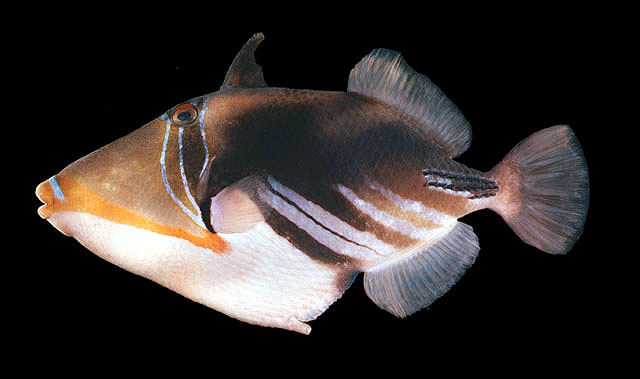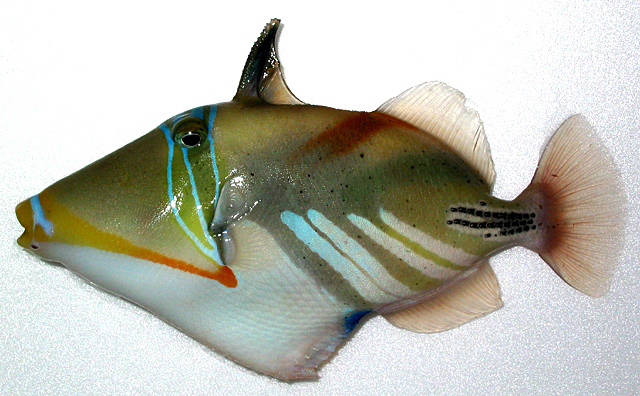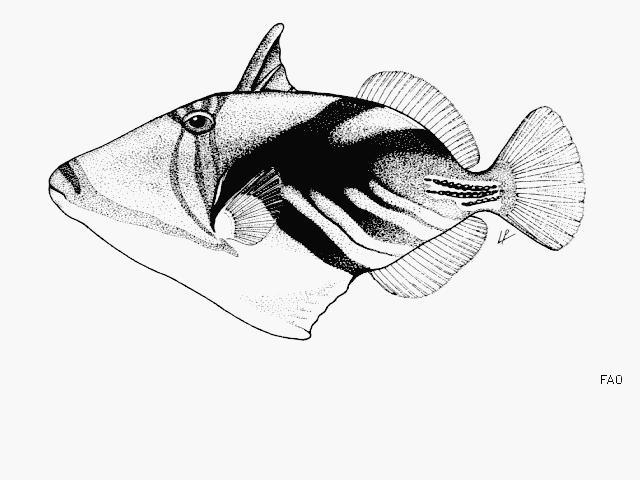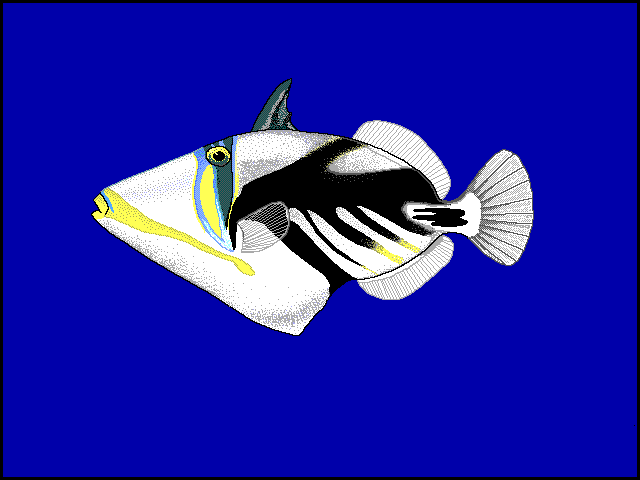Rhinecanthus
aculeatus
(Linnaeus,
1758)
White-banded triggerfish
View all media / Upload your photos and videos
Expand all
Classification / Names
Teleostei (teleosts) > Tetraodontiformes (Puffers and filefishes) >
Balistidae (Triggerfishes)
Etymology: Rhinecanthus: Greek, rhinos = nose + Greek, akantha = thorn (Ref. 45335).
More on author:
Linnaeus.
Environment / milieu / depth range / climate zone / distribution range
Marine; reef-associated; depth range 0 - 50 m (Ref. 7348); tropical; 30°N - 30°S -.
Distribution
Indo-Pacific: East Africa eastward through northern Australia to Hawaiian, Marquesas and Tuamotu islands, north to southern Japan.
Maps

Rhinecanthus aculeatus / Native range
AquaMaps Data sources:
GBIF
OBIS
This map was computer-generated and has not yet been reviewed.

Rhinecanthus aculeatus / Suitable habitat
AquaMaps Data sources:
GBIF
OBIS
This map was computer-generated and has not yet been reviewed.

Rhinecanthus aculeatus / Point map
AquaMaps Data sources:
GBIF
OBIS
This map was computer-generated and has not yet been reviewed.

Rhinecanthus aculeatus / Year 2050
AquaMaps Data sources:
GBIF
OBIS
This map was computer-generated and has not yet been reviewed.
Length at first maturity / Size / Weight / Age
Short description
Dorsal spines (total): 3; Dorsal soft rays (total): 23 - 26; Anal spines: 0; Anal soft rays: 21 - 23. Description: Characterized by generally whitish body color with yellow band from snout intersecting with dark bar through eye; dark brown area on middle of body connected to diagonal dark bands above anal fin; caudal fin base with rows of black dots; front of eye with deep groove; nearly straight dorsal and ventral head profiles; small, anterior projecting spines on caudal peduncle and adjacent posterior body in three horizontal rows; rounded caudal fin (Ref. 90102).
Biology
Commonly found in subtidal reef flats and shallow protected lagoons, Ref. 48637Benthopelagic (Ref. 58302). Juveniles secretive with rubble patches, adults swim about openly but are usually shy (Ref. 48637). Territorial. Feed on algae, detritus, mollusks, crustaceans, worms, sea urchins, fishes, corals, tunicates, forams, and eggs (Ref. 3921). Oviparous (Ref. 205). Sleep on its side; makes a whirring noise when alarmed (Ref. 4420). Also caught with drive-in nets and is considered a popular aquarium fish (Ref. 9770).
Life cycle and mating behavior
Distinct pairing (Ref. 205). Mating system may be a mixture of polygyny, monogamy, and potential promiscuity in solitary females but the primary mating system considered for this species is polygyny (Ref. 116439). Females are territorial, solely tending and guarding the eggs (Ref. 116451). Males exhibit polygyny (Ref. 116451).
Main reference
Myers, R.F. 1991 Micronesian reef fishes. Second Ed. Coral Graphics, Barrigada, Guam. 298 p. (Ref. 1602)
IUCN Red List Status (Ref. 125652)
Least Concern (LC); date assessed: January 14 2022
CITES (Ref. 131153)
Not Evaluated
CMS (Ref. 116361)
Not Evaluated
Threat to humans
Reports of ciguatera poisoning (Ref. 130160)
More information
- Countries
- FAO areas
- Ecosystems
- Occurrences
- Introductions
- Stocks
- Ecology
- Diet
- Food items
- Food consumption
- Ration
- Common names
- Synonyms
- Metabolism
- Predators
- Ecotoxicology
- Reproduction
- Maturity
- Spawning
- Spawning aggregation
- Fecundity
- Eggs
- Egg development
- Age/Size
- Growth
- Length-weight
- Length-length
- Length-frequencies
- Morphometrics
- Morphology
- Larvae
- Larval dynamics
- Recruitment
- Abundance
- References
- Aquaculture
- Aquaculture profile
- Strains
- Genetics
- Allele frequencies
- Heritability
- Diseases
- Processing
- Mass conversion
- Vision
- Pictures
- Stamps, Coins Misc.
- Sounds
- Ciguatera
- Speed
- Swim. type
- Gill area
- Otoliths
- Brains
Estimates based on models
Preferred temperature (Ref. 123201): 24.5 - 29, mean 27.7 °C (based on 1010 cells).
Phylogenetic diversity index (Ref. 82804): PD50 = 0.5078 [Uniqueness, from 0.5 = low to 2.0 = high].
Bayesian length-weight: a=0.01995 (0.01145 - 0.03476), b=2.92 (2.77 - 3.07), in cm total length, based on LWR estimates for this species & (Sub)family-body (Ref. 93245).
Trophic level (Ref. 69278): 3.2 ±0.1 se; Based on diet studies.
Generation time: 2.7 ( na - na) years. Estimated as median ln(3)/K based on 1 growth studies.
Resilience (Ref. 120179): High, minimum population doubling time less than 15 months (K=0.4).
Fishing vulnerability (Ref. 59153): Low to moderate vulnerability (30 of 100).
Price category (Ref. 80766): Medium; Very questionable: based on ex-vessel price for species in this family.
Nutrients (Ref. 124155): Calcium = 46.5 [19.5, 110.3] mg/100g; Iron = 0.619 [0.323, 1.399] mg/100g; Protein = 18.3 [16.2, 20.5] %; Omega3 = 0.115 [0.058, 0.223] g/100g; Selenium = 34.7 [18.2, 72.2] μg/100g; VitaminA = 54.6 [15.8, 190.6] μg/100g; Zinc = 1.12 [0.76, 1.64] mg/100g (wet weight);







